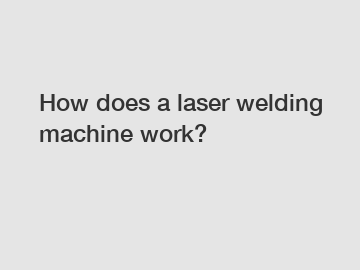How does a laser welding machine work?
As technology continues to advance at a rapid pace, industries such as manufacturing and construction benefit from cutting-edge innovations. One such remarkable advancement is the laser welding machine. These sophisticated devices are revolutionizing the welding industry, enabling precise and efficient joining of materials with unparalleled quality. In this article, we'll delve into the inner workings of laser welding machines, uncovering the mysteries behind their remarkable functionality.
Understanding Laser Welding:
Unlike traditional welding techniques that rely on heat generated by an electric arc or an open flame, laser welding utilizes a focused beam of light to achieve precision welding. The laser beam, emitted from a high-power source, is precisely controlled and directed onto the materials to be joined. This focused energy provides intense heat, causing the material to melt locally without any additional filler material.

Key Components of a Laser Welding Machine:
1. Laser Source: The quality of the laser beam emitted by the source determines the efficiency and effectiveness of the welding process. Laser sources are typically categorized into two types: solid-state (such as Nd:YAG or Fiber lasers) and gas (CO2) lasers. These sources generate powerful and concentrated beams necessary for successful welding.
2. Beam Delivery System: The beam delivery system consists of multiple components that guide the laser beam from the source to the workpiece. It includes mirrors, lenses, and optical fibers, ensuring accurate beam positioning and maintaining the required focus distance.
3. Workstation: The workstation comprises the stage where the workpiece is secured during the welding process. It includes fixtures, clamps, or robotic arms to provide stability and precision, ensuring that the materials are held securely and aligned accurately.
4. Control System: The control system is responsible for managing the laser's power, speed, and various other parameters during the welding process. It ensures that the laser operates with the desired intensity, duration, and pulse frequency, providing consistent and high-quality welds.
How Does Laser Welding Work?
Laser welding operates based on the principle of thermodynamics. The intense laser beam rapidly heats the materials, causing them to melt and fuse together. The process can be further divided into the following steps:
1. Preparation: Prior to welding, the materials to be joined are carefully prepared, ensuring clean and compatible surfaces. Alignment and fixation of the materials are crucial to achieve precise welds.
2. Beam Focus: The laser beam is tightly focused by the optics system to achieve high power density at the desired welding point. This concentrated beam allows for localized heating, minimizing the heat-affected zone and avoiding any damage to the surrounding areas.
3. Material Interaction: As the focused laser beam interacts with the materials, heat energy is absorbed, causing rapid melting and subsequent fusion. The energy and duration of the laser pulse depend on the characteristics of the materials and the desired weld quality.
4. Solidification: Once fusion occurs, the molten materials rapidly cool and solidify, creating a durable and seamless weld joint. The speed of solidification influences the strength and integrity of the weld, requiring precise control of the laser beam parameters.
Benefits of Laser Welding:
Laser welding offers a multitude of advantages over traditional welding methods, making it increasingly popular across different sectors. Some notable benefits include:
1. Precision: Laser welding allows for intricate and precise welds, even on small or delicate components. This precision minimizes the need for extensive rework or post-welding processes.
2. Speed and Efficiency: Compared to conventional welding, laser welding is significantly faster. The concentrated energy allows for quick and repeatable welds, improving productivity and reducing production costs.
3. Versatility: Laser welding can be employed to join a wide range of materials, including metals, plastics, and even dissimilar materials. This versatility widens the scope of applications in numerous industries.
4. Quality and Aesthetics: The controlled heat input of laser welding results in neat, aesthetically pleasing welds with minimal distortion. The absence of filler materials eliminates the possibility of contamination or weakening of the joint.
Conclusion:
With its remarkable precision, efficiency, and versatility, the laser welding machine has transformed the welding process, providing superior results in various industries. By harnessing the power of focused light, laser welding has revolutionized the way materials are joined together. As technology continues to advance, we can only expect further improvements and wider adoption of this incredible technology.
So, whether it's in automotive manufacturing, aerospace, or electronics, laser welding shines as a game-changer, supporting innovation and fueling progress in various sectors.
For more alloy steel fiber laser cutter machine manufacturer, laser tube cutting machine for sale, fiber laser cutter machine manufacturerinformation, please contact us. We will provide professional answers.

Comments